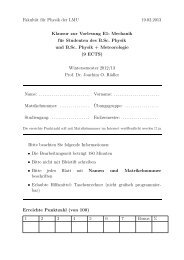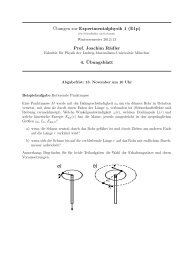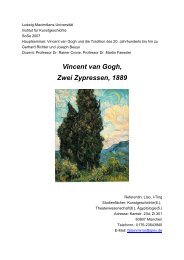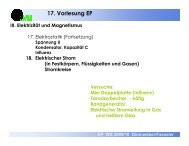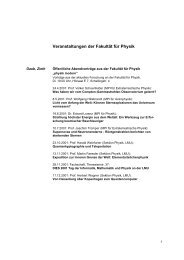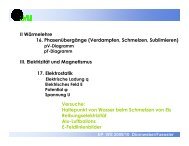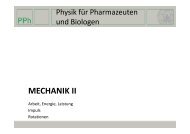Ultrapure, high mobility organic photoconductors
Ultrapure, high mobility organic photoconductors
Ultrapure, high mobility organic photoconductors
You also want an ePaper? Increase the reach of your titles
YUMPU automatically turns print PDFs into web optimized ePapers that Google loves.
164 W. Warta et al.<br />
The investigations presented here are part of a larger<br />
program designed to obtain reliable experimental data<br />
over wide temperature ranges on charge-cartier trans-<br />
port in <strong>organic</strong> <strong>photoconductors</strong>. Naphthalene and<br />
perylene were selected, among others, to serve as model<br />
substances. Naphthalene is one of the most simple<br />
aromatic molecules; very extensive investigations are<br />
available of both its molecular and its crystal pro-<br />
perties. Its melting point, however, (m.p. = 80.5 ~ is<br />
too low for any potential practical application. In<br />
contrast, perylene, which melts at 278 ~ is an example<br />
of a fairly stable, larger aromatic molecule. Both<br />
materials can be zone-refined and obtained as fairly<br />
perfect single crystals by the Bridgman method.<br />
We have chosen not to measure the electrical conduc-<br />
tivity as such, since it is in the most general case<br />
composed of at least four independent material pro-<br />
perties: the electron and hole concentrations, n- and<br />
n +, and the electron and hole mobilities, #- and #+,<br />
respectively<br />
= e(n-#- + n+#+). (1)<br />
Instead, we decided to focus on the basic transport<br />
quantities, #- and/~+. These mobilities can, in prin-<br />
ciple, be measured separately by the time-of-flight<br />
technique, cf. [2], where the transit of electrons<br />
or holes over macroscopic sample dimensions (of<br />
typically 0.2-1 ram) is observed.<br />
However, most chemical impurities can very efficiently<br />
capture charge carriers during passage through the<br />
crystal, because the wide band gaps which are typical<br />
for this material class provide a wide energy range in<br />
which impurity states can act as traps. It is therefore<br />
crucial to study charge carrier transport properties at<br />
extremely low impurity concentrations. In addition,<br />
the concentration of physical (lattice) defects has to be<br />
kept low by careful annealing and handling of the<br />
crystals, since at the present level of chemical purity,<br />
physical defects can no longer be considered to give rise<br />
to only minor contributions for the total trapping<br />
behaviour.<br />
Traps which are energetically deep with respect to kT<br />
can completely prohibit the observation of carrier<br />
transits. Shallow traps can repeatedly hold charge<br />
carriers for short time intervals, until they are<br />
thermally released to the conduction states again. A<br />
strongly reduced, thermally activated "effective" mo-<br />
bility is therefore commonly observed in such cases,<br />
cf. [3]. The intrinsic transport properties, the "micro-<br />
scopic" mobilities (or "lattice mobilities") are ob-<br />
scured in such situations. Early <strong>mobility</strong> results have<br />
often suffered from these different trapping influences.<br />
(This is at least and definitely known to be so in<br />
cases where more efficient purification later led to<br />
<strong>high</strong>er, non-thermally activated <strong>mobility</strong> values.)<br />
Historically, the measured microscopic mobilities were<br />
often on the order of 1 cm2/Vs, cf. [4, 5] which is very<br />
small in comparison with the mobilities in standard<br />
in<strong>organic</strong> semiconductors, such as silicon or ger-<br />
manium. An increase of the mobilities # with decreas-<br />
ing temperature T, # oc T", (n < 0), was found with some<br />
of the purer samples: This increase was usually re-<br />
stricted to narrow temperature intervals near room<br />
temperature (and therefore not very big). The reason is<br />
that even very shallow trapping influences, not seri-<br />
ously disturbing room-temperature transport, can<br />
limit the observability of transits at lower tempera-<br />
tures, since the time constants for thermal detrapping<br />
increase exponentially on cooling. The reproducibility<br />
of mobifity results was sometimes rather poor between<br />
different laboratories, which may also have been due to<br />
(unknown) impurities which were present in variable<br />
amounts in the different samples.<br />
There were only three cases reported in the literature<br />
where crystal quality permitted reaching lower tem-<br />
peratures: The electron-<strong>mobility</strong> tensor component<br />
#~;~, in anthracene was measured down to liq. N2<br />
temperature [4, 6]; (surprisingly it exhibited the ab-<br />
normality of remaining nearly temperature-<br />
independent between 373 and 83 K, amounting to<br />
0.4cmZ/Vs). In naphthalene the observation of a<br />
transition from a nearly temperature-independent<br />
electron-<strong>mobility</strong> tensor component #~;c. = 0.4 cm2/Vs<br />
to one rising exponentially below 120 K was accom-<br />
plished in a measurement down to 31 K, where #~c.<br />
=2cmZ/Vs was reached [7]. Durene was the only<br />
example for which fairly <strong>high</strong> low-temperature mo-<br />
bilities have been reported (#+ = 55 cmZ/Vs at 120 K)<br />
[83.<br />
The aim of the work presented here was to improve<br />
purification procedures and to grow <strong>high</strong>-quality<br />
single crystals of naphthalene and perylene in order to<br />
find out if and to which maximum value intrinsic<br />
charge carrier mobilities continue to increase with<br />
decreasing temperature, and, if <strong>high</strong> charge carrier<br />
mobilities might eventually constitute a common low-<br />
temperature property of aromatic crystals.<br />
On our way to gradually increased purities we found,<br />
among other things, that temperature-dependent<br />
charge carrier <strong>mobility</strong> measurements represent a very<br />
sensitive analytical tool for the assessment of purity<br />
of <strong>organic</strong> aromatic crystals and we wish to focus on<br />
this aspect in this publication.<br />
Purification Procedures<br />
We started with the purest commercially available<br />
material (naphthalene "for scintillation", Merck, pery-<br />
lene "purum", Fluka). Naphthalene was prepurified by<br />
liquid chromatography. After vacuum sublimation,




